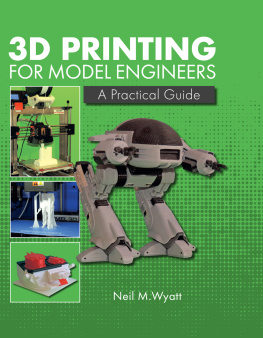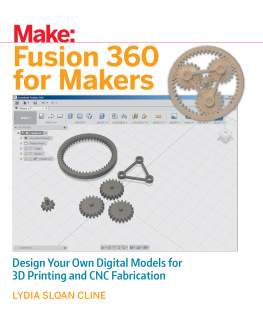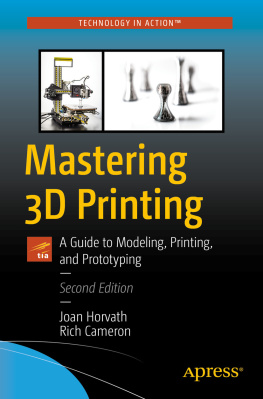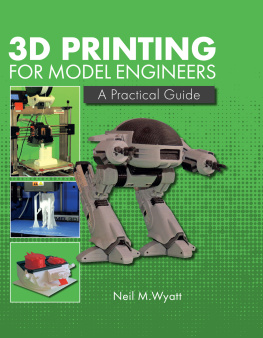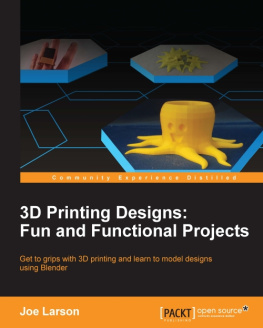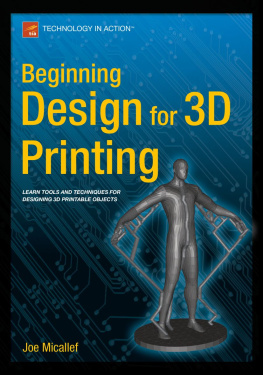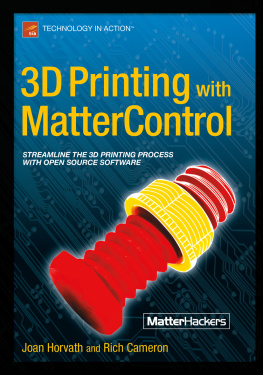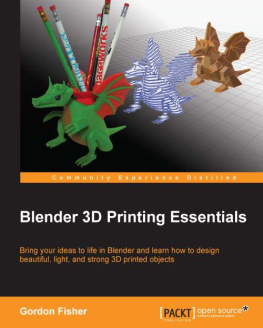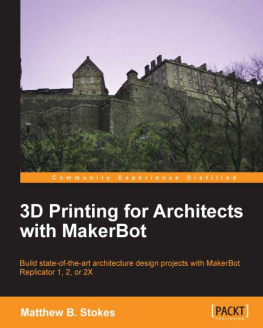Summary
Design for 3D Printing
by Samuel N. Bernier, Bertier Luyt, and Tatiana Reinhard
Copyright - Hachette-Livre (Marabout) 2014
Printed in Canada.
Published by Maker Media, Inc., 1160 Battery Street East, Suite 125, San Francisco, CA 94111.
Maker Media books may be purchased for educational, business, or sales promotional use. Online editions are also available for most titles (.
Editor: Brian Jepson
Interior Designer: Victor Grenez and Transparence
Cover Designer: Thomas Raygasse and Samuel N. Bernier
September 2015: First English Edition
Revision History for the First Edition
2015-09-23: First Release
See http://shop.oreilly.com/product/0636920032052.do for release details.
The Make logo is a registered trademark of Maker Media, Inc. Design for 3D Printing, the cover image, and related trade dress are trademarks of Maker Media, Inc.
Many of the designations used by manufacturers and sellers to distinguish their products are claimed as trademarks. Where those designations appear in this book, and Maker Media, Inc. was aware of a trademark claim, the designations have been printed in caps or initial caps.
While the publisher and the author have used good faith efforts to ensure that the information and instructions contained in this work are accurate, the publisher and the author disclaim all responsibility for errors or omissions, including without limitation responsibility for damages resulting from the use of or reliance on this work. Use of the information and instructions contained in this work is at your own risk. If any code samples or other technology this work contains or describes is subject to open source licenses or the intellectual property rights of others, it is your responsibility to ensure that your use thereof complies with such licenses and/or rights.
978-1-4571-8736-0
[TI]
DESIGN FOR 3D PRINTING
SCANNING, CREATING, EDITING, REMIXING, AND MAKING IN THREE DIMENSIONS
SAMUEL N. BERNIER
BERTIER LUYT
TATIANA REINHARD
BEFORE YOU START
To follow the exercises in this book, you have to download several free software packages, which will allow you to learn the basics of modeling for 3D printing.
On the www.123dapp.com/create website, you can easily download 123D Design and Meshmixer.
If you have an iPad, iPhone, Windows Phone, or Android phone or tablet, you can download 123D Catch from your devices application store. You can get 123D Sculpt for iPad on the App Store.
You will also have to download the Netfabb Basic software from www.netfabb.com website. This one will allow you to quickly cut and repair 3D files.
The free or paid version of Skanect will also be necessary for the 3D scan exercise, as well as a Microsoft Kinect (Xbox or Windows version, but not Kinect One), an Asus Xtion Pro, or Structure Sensor: www.skanect.com.
FOREWORD BY CARL BASS
Maker and CEO, Autodesk
To paraphrase that old Hollywood witticism, 3D printing is an overnight success 30 years in the making...
Starting in the early 1980s, 3D printing has transformed from an experimental technique developed by a few early innovatorslike Hideo Kodama and Chuck Hullto a global movement embraced by millions of people all over the world.
For me, as someone who has always loved making thingsboats, benches, baseball bats, and even rocket ships with my kidsits been exciting to watch and even take part in this transformation; and today our company, Autodesk, is helping bring 3D printing to as many people as possible.
Thats why Im so happy to see a book about 3D printing written by true practitioners like Samuel, Bertier and Tatiana. In their FabShop in Paris, they do 3D printing every day, and they have a passion for teaching what they know to others. Their shop is always humming with activity and experimentation, and in the pages of this book theyve captured that sense of excitement about doing new things with new technologies.
Inside youll find a compelling depiction of the history of 3D printing, as well as lots of good How To sections and exercises to try. I think this combination of theory and practice will give the reader a deeper understanding of 3D printing to really learn what all the excitement is about.
I love the fact that 3D printing lets us do things we couldnt do before, and sometimes even things we couldnt conceive of before.
And I think that some of the readers of this book could be the ones to make the inconceivable, conceivable...
INTRODUCTION
Today, everyones talking about it. To hear some manufacturers and journalists talk, you will have a 3D printer in your home in a few months or the next few years. Why wait for the future? For many people, there is already one available at your business, your school, your local library, or through online 3D printing services such as 3D Hubs.
All industries (at least those who produce physical things) use or will soon use 3D printing in their innovation processes: in the early development phase of prototyping as well as for the producing certain specialized or limited-run pieces, for which traditional methods of manufacturing are less adapted today.
At le FabShop, we use 3D printing every day: we set it up and teach our clients and the curious how to use it. We are makers, new and connected DIYers who use 3D printing regularly, and we share some of our work on our website and on community websites.
This book project was born from our experience. If 3D printing ends up changing the world and, tomorrow, it is universally available at home or just down the street, then it needs to be made practical for the largest number of people.
To print an object in 3D, you need a 3D model and a 3D printer. To obtain a 3D model, there are three possible sources: 3D modeling software that lets you create an original model, a 3D scanner that allows you to virtualize a real object, or websites for downloading 3D files. We will explain later how to use one or the other of these solutions through practical exercises. We will also see what the major 3D printing technologies are, and which 3D printer to choose depending on the project and available materials.
If, at the moment 3D printing processes are still rather slow compared to industrial manufacturing processes, the future of these technologies is being played out today.
Dimensions, manufacturing time, available materials and the possibilities of combining materials are the areas that researchers, enthusiasts, and businesses around the world are working on.
Its time to get on this train because its already on its way!
WHAT IS 3D PRINTING?
3D printing is a style of manufacturing technique known as an additive, as opposed to subtractive, process (even automated or robotized ones) that work by removing material. Subtractive techniques all have a certain number of limitations inherent in the methods of production. Indeed, to produce the final object, you need to start with a block of material, which causes waste and limits formal complexity.
Lets take, for example, the traditional way of manufacturing a wooden chair leg: a tree is cut down, the bark and branches are removed, and it is cut into boards. The boards, once dried, are planed, sawed, machined, and sanded. To make the same leg in plastic, you have to create a mold made from a block of metal, which the melted plastic will be injected into using a gigantic press.



